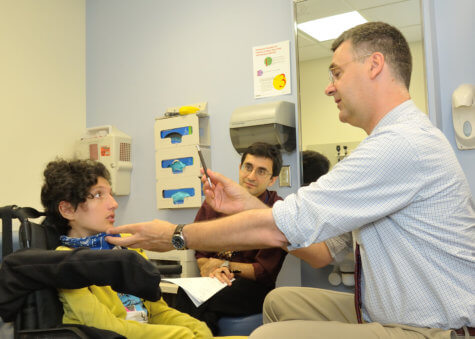BETHESDA, Md. — Amyotrophic lateral sclerosis (ALS) typically attacks the neurological function of people in their 50s or 60s. However, a recent study has discovered a new, slow-developing form of the disease which attacks toddlers instead. While the news is frightening for any parent, researchers with the National Institutes of Health add they have also discovered the specific gene which may hold the key to stopping this condition.
Study authors, examining 11 “medical-mystery” patients, say this form of ALS develops during childhood and gradually worsens over the next few decades. Their study finds the disease has a link to the SPTLC1 gene, which is part of the body’s fat production system. In early experiments, researchers believe silencing this gene’s activity may help doctors create a treatment for these children.
“ALS is a paralyzing and often fatal disease that usually affects middle-aged people. We found that a genetic form of the disease can also threaten children. Our results show for the first time that ALS can be caused by changes in the way the body metabolizes lipids,” says Carsten Bönnemann, M.D., senior investigator at the NIH’s National Institute of Neurological Disorders and Stroke (NINDS) in a media release.
“We hope these results will help doctors recognize this new form of ALS and lead to the development of treatments that will improve the lives of these children and young adults. We also hope that our results may provide new clues to understanding and treating other forms of the disease.”
New ALS form takes much longer to become fatal

Study authors first started their investigation into this childhood illness with Claudia Digregorio, a young woman in Italy. Her medical issues were so mysterious that even Pope Francis met her in-person to give his blessing.
Like many ALS patients, Claudia needed a wheelchair to move and doctors implanted a tracheostomy tube so she could breathe. Neurological scans at the NIH’s Clinical Center revealed many of the hallmark signs of ALS, including severely weakened or paralyzed muscles.
Despite the similarities, this form of the disease is radically different in its progression. Doctors diagnose most cases of ALS during middle age. From there, the disease rapidly worsens, leading to paralysis and death within five years of diagnosis.
This form of ALS however, starts with the same initial symptoms, such as toe walking and abnormal muscle tightness, but they appear around the age of four. Study authors add these patients lived anywhere from five to 20 years longer than the typical case of ALS.
“These young patients had many of the upper and lower motor neuron problems that are indicative of ALS,” explains Payam Mohassel, M.D., an NIH clinical research fellow. “What made these cases unique was the early age of onset and the slower progression of symptoms. This made us wonder what was underlying this distinct form of ALS.”
Revealing the gene responsible
Scientists discovered the roots of this condition after analyzing the DNA of each ALS patient. The team used high-tech genetic tools which look at exomes, the sequences of DNA that carry instructions for making proteins.
Researchers found these patients each had noticeable changes in the same specific portion of their SPLTC1 gene. Four inherited this mutation from a parent’s genes. The other six cases appear to be the result of what the research team calls “de novo” mutations. These changes spontaneously occur when cells rapidly multiply before or right after conception.
Study authors say SPLTC1 gene mutations can also cause other neurological conditions, like hereditary sensory and autonomic neuropathy type 1 (HSAN1). SPLTC1 proteins are a part of an enzyme called SPT. It accelerates the reactions which make sphingolipids, a specific type of lipids (fats) which are critical to the water barrier in skin. Usually, these mutations create harmful version of sphingolipids, but the team did not find the same problems in the ALS patients.
“At that point, we felt like we had hit a roadblock. We could not fully understand how the mutations seen in the ALS patients did not show the abnormalities expected from what was known about SPTLC1 mutations,” notes Dr. Bönnemann. “Fortunately, Dr. Dunn’s team had some ideas.”
Silencing the ALS gene
Dr. Teresa Dunn, from the Uniformed Services University, and her team re-examined the blood from the ALS patients and discovered abnormally high levels of sphingolipids. Those findings suggested that ALS mutations cause SPT activity to increase in patients.
Through a series of experiments on lab-grown neurons in petri dishes, Dr. Dunn’s team revealed that ALS-causing mutations stop a different protein, ORMDL, from keeping SPT activity under control.
“Our results suggest that these ALS patients are essentially living without a brake on SPT activity. SPT is controlled by a feedback loop. When sphingolipid levels are high then ORMDL proteins bind to and slow down SPT. The mutations these patients carry essentially short circuit this feedback loop,” Dr. Dunn reports. “We thought that restoring this brake may be a good strategy for treating this type of ALS.”
Dr. Bönnemann’s team then created small interfering strands of RNA which could turn off the mutant SPLTC1 genes in ALS patients. Early experiments on the patient’s skin cells reveal these specialized RNA strands successfully silence SPLTC1 gene activity and restore the sphingosine levels to normal.
“These preliminary results suggest that we may be able to use a precision gene silencing strategy to treat patients with this type of ALS. In addition, we are also exploring other ways to step on the brake that slows SPT activity,” Dr. Bönnemann concludes. “Our ultimate goal is to translate these ideas into effective treatments for our patients who currently have no therapeutic options.”
The findings appear in the journal Nature Medicine.
